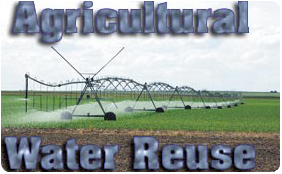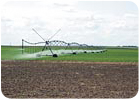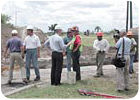
Agricultural irrigation represents a significant percentage of the total demand for freshwater. Agricultural irrigation is estimated to represent 40 percent of the total water demand nationwide. In western states with significant agricultural production, the percentage of freshwater used for irrigation is markedly greater. The total cropland area in the United States and Puerto Rico is estimated to be approximately 431 million acres, of which approximately 55 million acres are irrigated. Worldwide, it is estimated that irrigation water demands exceed all other categories of water use, and make up 75 percent of the total water usage.
A significant portion of existing water reuse systems supply reclaimed water for agricultural irrigation. In Florida, agricultural irrigation accounts for approximately 19 percent of the total volume of reclaimed water used within the state. In California, agricultural irrigation accounts for approximately 48 percent of the total volume of reclaimed water used within the state.
Agricultural reuse often is included as a component in water reuse programs for the following reasons:
- Extremely high water demands for agricultural irrigation.
- Significant water conservation benefits associated with reuse in agriculture.
- Ability to integrate agricultural reuse with other reuse applications.

Estimating Demand
Because crop water requirements vary with climatic conditions, the need for supplemental irrigation will vary from month to month throughout the year. This seasonal variation is a function of rainfall, temperature, crop type, stage of plant growth and other factors, depending on the method of irrigation being used.The supplier of reclaimed water must be able to quantify these seasonal demands, as well as any fluctuation in the reclaimed water supply, to assure that the demand for irrigation water can be met. Unfortunately, many agricultural users are unable to provide sufficient detail about irrigation demands for design purposes. This is because the user's seasonal or annual water use seldom is measured and recorded, even on land surfaces where water has been used for irrigation for a number of years. However, expert guidance usually is available through state colleges and universities and the local soil conservation service office. To assess the feasibility of reuse in the absence of actual water use data, evapotranspiration, percolation and runoff losses, and net irrigation must be estimated.
Evapotranspiration is defined as water either evaporated from the soil surface or actively transpired from the crop. While the concept of evapotranspiration is easily described, quantifying the term mathematically is difficult. Evaporation from the soil surface is a function of the soil moisture content at or near the surface. As the top layer of soil dries, evaporation decreases. Transpiration, the water vapor released through the plants' surface membranes, is a function of available soil moisture, season and stage of growth. The rate of transpiration may be further impacted by soil structure and the salt concentration in the soil water. Primary factors affecting evaporation and transpiration are relative humidity, wind and solar radiation.
The approach for the beneficial reuse of reclaimed water will, in most cases, vary significantly from land application. In the case of beneficial reuse, the reclaimed water is a resource to be used judiciously. The prudent allocation of this resource becomes even more critical in locations where reclaimed water is assigned a dollar value, thereby becoming a commodity. Where there is a cost associated with using reclaimed water, the recipient of reclaimed water will seek to balance the cost of supplemental irrigation against the expected increase in crop yields to derive the maximum economic benefit. Thus, percolation losses will be minimized because they represent the loss of water available to the crop and wash fertilizers out of the root zone. An exception to this occurs when the reclaimed water has a high salt concentration and excess application is required to prevent the accumulation of salts in the root zone.
Irrigation demand is the amount of water required to meet the needs of the crop and also overcome system losses. System losses will consist of percolation, surface water runoff and transmission and distribution losses. In addition to the above losses, the application of water to crops will include evaporative losses or losses due to wind drift. These losses may be difficult to quantify individually and often are estimated as single system efficiency. The actual efficiency of a given system will be site-specific and vary widely depending on management practices followed. Irrigation efficiencies typically range from 40 percent to 98 percent.
Since there are no hard and fast rules for selecting the most appropriate method for projecting irrigation demands and establishing parameters for system reliability, it may be prudent to undertake several of the techniques and to verify calculated values with available records. In the interest of developing the most useful models, local irrigation specialists should be consulted.

Reclaimed Water Quality
The chemical constituents in reclaimed water of concern for agricultural irrigation are salinity, sodium, trace elements, excessive chlorine residual and nutrients. Sensitivity generally is a function of a given plant's tolerance to constituents encountered in the root zone or deposited on the foliage. Reclaimed water tends to have higher concentrations of these constituents than the ground water or surface water sources from which the water supply is drawn.The types and concentrations of constituents in reclaimed wastewater depend upon the municipal water supply, the influent waste streams (i.e., domestic and industrial contributions), amount and composition of infiltration in the wastewater collection system, the wastewater treatment processes and type of storage facilities. Conditions that can have an adverse impact on reclaimed water quality may include elevated total dissolved solids (TDS) levels, industrial discharges of potentially toxic compounds into the municipal sewer system, and saltwater (chlorides) infiltration into the sewer system in coastal areas.
Salinity - Salinity is the single most important parameter in determining the suitability of the water to be used for irrigation. Estimates indicate that 23 percent of irrigated farmland has been damaged by salt. The salinity tolerance of plants varies widely. Crops must be chosen carefully to ensure that they can tolerate the salinity of the irrigation water, and even then the soil must be properly drained and adequately leached to prevent salt build-up. Leaching is the deliberate over-application of irrigation water in excess of crop needs to establish a downward movement of water and salt away from the root zone.
The extent of salt accumulation in the soil depends on the concentration of salts in the irrigation water and the rate at which salts are removed by leaching. Salt accumulation can be especially detrimental during germination and when plants are young (seedlings). At this stage, damage can occur even with relatively low salt concentrations. Concerns with salinity relate to the soil's osmotic potential, specific ion toxicity and degradation of soil physical conditions. These conditions may result in reduced plant growth rates, reduced yields, and, in severe cases, total crop failure.

Sodium salts influence the exchangeable cation composition of the soil, which lowers the permeability and affects the tilth of the soil. This usually occurs within the first few inches of the soil and is related to high sodium or very low calcium content in the soil or irrigation water. Sodium hazard does not impair the uptake of water by plants but does impair the infiltration of water into the soil.
Trace Elements - The elements of greatest concern at elevated levels are cadmium, copper, molybdenum, nickel and zinc. Nickel and zinc have visible adverse effects in plants at lower concentrations than the levels harmful to animals and humans. Zinc and nickel toxicity is reduced as pH increases. Cadmium, copper and molybdenum, however, can be harmful to animals at concentrations too low to impact plants.
In addition, it was found that the input of heavy metals from commercial chemical fertilizer impurities was far greater than that contributed by the reclaimed water.
Chlorine Residual - Free chlorine residual at concentrations less than 1 mg/l usually poses no problem to plants. However, some sensitive crops may be damaged at levels as low as 0.05 mg/l. Some woody crops, however, may accumulate chlorine in the tissue to toxic levels. Excessive chlorine has a similar leaf-burning effect as sodium and chloride when sprayed directly on foliage. Chlorine at concentrations greater than 5 mg/l causes severe damage to most plants.
Nutrients - The nutrients most important to a crop's needs are nitrogen, phosphorus, potassium, zinc, boron and sulfur. Reclaimed water usually contains enough of these nutrients to supply a large portion of a crop's needs. The most beneficial nutrient is nitrogen. Both the concentration and form of nitrogen need to be considered in irrigation water. While excessive amounts of nitrogen stimulate vegetative growth in most crops, it also may delay maturity and reduce crop quality and quantity. The nitrogen in reclaimed water may not be present in concentrations great enough to produce satisfactory crop yields, and some supplemental fertilizer may be necessary.
In addition, excessive nitrate in forages can cause an imbalance of nitrogen, potassium and magnesium in grazing animals. This is a concern if the forage is used as a primary feed source for livestock; however, such high concentrations usually are not expected with municipal reclaimed water.

Numerous site-specific studies have been conducted regarding the potential water quality concerns associated with reuse irrigation. The overall conclusions:
- Irrigation with filtered effluent (FE) or Title-22 effluent (T-22) appears to be as safe as well water.
- Few statistically significant differences were found in soil or plant parameters, and none were found to be attributable to different types of water. None of the differences had important implications for public health.
- Yields of annual crops often were significantly higher with reclaimed water.
- No viruses were detected in any of the reclaimed waters, although viruses often were detected in the secondary effluent prior to the reclamation process.
- The T-22 process was somewhat more efficient than the FE process in removing viruses when the influent was seeded at high levels of virus concentration. However, both processes demonstrated the ability to remove viruses during seeding experiments.
Other Considerations
In addition to irrigation supply and demand and reclaimed water quality requirements, there are other considerations specific to agricultural water reuse that must be addressed.System Reliability - System reliability involves two basic issues. First, as in any reuse project that is implemented to reduce or eliminate surface water discharge, the treatment and distribution facilities must operate reliably to meet permit conditions. Second, the supply of reclaimed water to the agricultural user must be reliable in quality and quantity for successful use in a farming operation.
Site Use Control - Many states require a buffer zone around areas irrigated with reclaimed water. The size of this buffer zone often is associated with the level of treatment the reclaimed water has received and the means of application. Additional controls may include restrictions on the times that irrigation can take place and restrictions on the access to the irrigated site. Such use of area controls may require modification to existing farm practices and limit the use of reclaimed water to areas where required buffer zones cannot be provided. Signs specifying that reclaimed water is being used may be required to prevent accidental contact or ingestion.
Monitoring Requirements - Monitoring requirements for reclaimed water use in agriculture differ by state. In most cases, the supplier will be required to sample the reclaimed water quality at specific intervals for specific constituents. Sampling may be required at the water reclamation plant and, in some cases, in the distribution system.
Ground water monitoring often is required at the agricultural site, with the extent depending on the reclaimed water quality and the hydrogeology of the site. Ground water monitoring programs may be as simple as a series of surficial wells to a complex arrangement of wells sampling at various depths. Monitoring must be considered in estimating the capital and operating costs of the reuse system, and a complete understanding of monitoring requirements is needed as part of any cost/benefit analysis.
Some irrigation practices, such as flood irrigation, result in a discharge of irrigation water from the site. Regulatory restrictions of this discharge may be few or none when using surface water or ground water sources; however, when reclaimed water is used, runoff controls may be required to prevent discharge or a National Pollutant Discharge Elimination System permit may be required for a surface water discharge.

Irrigation Equipment - By and large, few changes in equipment are required to use reclaimed water for agricultural irrigation. However, some irrigation systems do require special considerations.
Surface irrigation systems normally result in the discharge of a portion of the irrigation water from the site. Where reclaimed water discharge is not permitted, some method of tail water return or pump-back may be required.
In sprinkler systems, dissolved salts and particulate matter may cause clogging, depending on the concentrations of these constituents as well as the nozzle size. Because water droplets or aerosols from sprinkler systems are subject to wind drift, the use of reclaimed water may necessitate the establishment of buffer zones around the irrigated area. In some types of systems (i.e., center pivots), the sprinkler nozzles may be dropped closer to the ground to reduce aerosol drift and thus minimize the buffer requirements. In addition, some regulatory agencies restrict the use of sprinkler irrigation for crops to be eaten raw, because it results in the direct contact of reclaimed water with the fruit.
When reclaimed water is used in a micro-irrigation system, a good filtration system is required to prevent complete or partial clogging of emitters. Close, regular inspections of emitters are required to detect emitter clogging. In-line filters of an 80 mesh to 200 mesh typically are used to minimize clogging. In addition to clogging, biological growth within the transmission lines and at the emitter discharge may be increased by nutrients in the reclaimed water. Due to low volume application rates with micro-irrigation, salts may accumulate at the wetted perimeter of the plants and then be released at toxic levels to the crop when leached via rainfall. ND
Report Abusive Comment